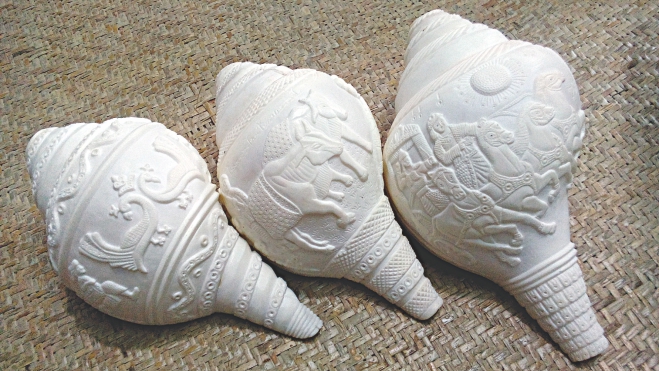The art of the shakhari

If you ever decide to pay a visit to the famous Shakhari Bazaar in Old Dhaka, make sure you stop by Sridhar Shankha Bhandar for a glimpse into the history of this 400-year-old neighbourhood. Tamo Nag, the proprietor of this shop, still practices the craftwork mastered by his forefathers for generations--the art of making shakhas and shankhas, the trade that gave Shakhari Bazaar its name.
The Shakhari community which derives its name from the ornate hand crafted conch shell bangles (shakhas) they produce have been around since the pre-Mughal times if not earlier. These bangles are worn by Hindu women as proof of their married status. “I have been making Shakhas and Shankhas (decorated conch shells used for Puja) since I was 22 years old,” says Tamo Nag, who is one of the few Shakharis left from the once flourishing community, “I started learning from my father at a very young age, which is a part of my family tradition. It took me eight years to master the craft,” he explains.

Unlike many members of his community who resort to machines to make their product, saving time and earning quick money, Tamo stays true to the old tradition of hand-crafting his product with the Terabari and Mandabari. This is a quaint looking structure constructed from blocks of wood and sticks that acts as an easel, supported by a shilpata (cement block). He uses a thin metal file to carve intricate patters of flowers, leaves, peacocks, elephants, and various designs from his imagination. “I also carve stories from our Hindu scripture such as the Ramayan and Geeta on the Shankhas,” Tamo says.
Tamo Nag and his son Bappi Nag's work has been featured in various exhibitions at the Bangabandhu International Conference Centre, the Bengal Art Gallery, Dhanmondi Field, Shilpakala Academy among others. He even had an exhibition in Japan. His son and protégée Bappi Nag won the Master Crafts Award from the National Arts Council last year. During his exhibition at Beauty Boarding in Old Dhaka, organised in honour of a princess of Denmark, Tamo presented her with an elaborately carved Shakha of his own creation.

Unfortunately, despite Tamo Nag's effort of keep this traditional craft alive, many Shakharis have left their profession due to their suffering business. “The government now charges 40 percent tax on the conch shells we import from Sri-Lanka as raw material,” explains Tamo, “On the other hand they import Shakhas and Shankhas from India free of taxes and sell them at a much cheaper price. There was once at least thirty craftsmen working in my shop, we now have one. There are probably less than fifteen to twenty Shakharis left in this area. Business is failing,” he worries.
Tama Nag and his fellow Shakharis, with the help of Bengal Foundation and the National Arts Council are protesting the high tax rates and promoting their craft through various exhibitions. They hope they can still revive this dying art and centuries old tradition.


 For all latest news, follow The Daily Star's Google News channel.
For all latest news, follow The Daily Star's Google News channel. 



Comments